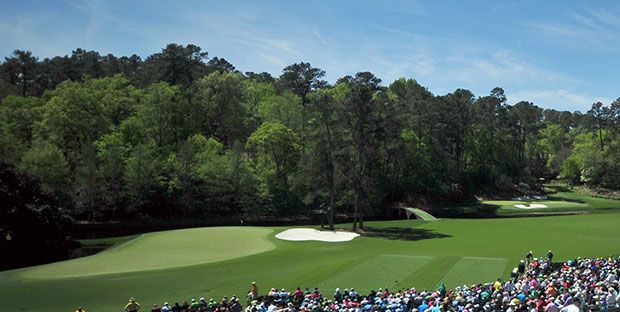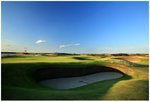- Joined
- Mar 17, 2018
- Messages
- 20,099
- Reaction score
- 28,342
- Handicap
- 18.0
The World Greatest Golf Course Final Matchup is here.
We have the best, voted by forum members here on THP, from the USA side the number 1 seeded Augusta National vs from the International side the number 1 seeded St. Andrews Old Course
Here is the thread to show the full pool and all the results. You decide on which is the World's Greatest Golf Course.
https://www.thehackersparadise.com/...ss-greatest-golf-course-in-the-world.8916364/
It's history vs history, private vs public. Who is going?
(1) Augusta National Golf Club

Augusta National Holes 1 - 6
No. 1 - Tea Olive
Par 4, 445 Yards
The slight dogleg right is not the easiest tee shot golfers will face. Carrying the fairway bunker will require a drive of 300 yards, and shorter hitters will face an uphill shot to the undulating green.

*********
No. 2 - Pink Dogwood
Par 5, 575 Yards
A slight draw off the tee sets up a chance to reach the par-5 green in two. Bunkers in front of the green often come into play.

********
No. 3 - Flowering Peach
Par 4, 350 yards
Most players opt for position off the tee with a long iron or a fairway wood. The small green, which slopes from right to left, is not entirely visible from the fairway.

************
No. 4 Flowering Crabapple
Par 3, 240 yards
This tough par-3 requires a long-iron shot to the green, which is guarded by a pair of bunkers.

*************
No. 5 - Magnolia
Par 4, 495 yards
The deep fairway bunkers on the left require a carry of 313 yards around the dogleg. Large humps in the green make it a challenging putting surface.

************
No. 6 - Juniper
Par 3, 180 yards
This downhill par-3 usually requires no more than a medium iron to the large, undulating green. Put the ball on the wrong part of the green, however, and a three-putt is likely.

************
(1) St. Andrews Old Course

St. Andrews Old Course Holes 1 - 6
Hole No. 1
Par 4, 376 yards

It’s the easiest opening tee shot in championship golf, and also the most nerve-racking. The hole is fraught with history, tradition, the peering eyes of the R&A members from the nearby clubhouse and the prospects of trying not to go out-of-bounds right (easily within play!) or left (only Ian Baker-Finch has done it in the Open) on a fairway that’s 100 yards wide. No need for a river here; the important shot is the approach, invariably a short iron except into the heaviest of westerly winds. Interestingly, the second shot here, across a stone-lined burn fronting the green, is the only forced carry across an irrecoverable hazard on the entire course. It’s the gentlest of opening-hole handshakes.
No. 2: "Dyke"
Par 4, 453 yards

The next six holes, all running straight north, normally play with the prevailing wind coming in from the left – a westerly. But if, as seems the case this week, the wind blows out of the south, then here’s the stretch to make up considerable ground before squandering it on the incoming nine. On most of the holes at St. Andrews, the clearer, more open line into the green is revealed by a bold drive down the tighter right side – with out-of-bounds and heavy stands of gorse and broken ground lining that side. Everyone talks about the safer side being to the left along the lines into the wide, shared double fairways here. But this safer drive leaves a much tougher second shot at the second hole and throughout the Old Course into greens defended heavily short and left of center. R&A chief executive Peter Dawson, who will be retiring this year, recently oversaw addition of a new bunkering scheme that placed a two new hazards in front of the ideal landing zone. They probably will end up helping players by giving them an ideal drop zone rather than having them figure out from ill-defined terrain where to land the ball. The second hole presents the first of the seven famed double-greens at St. Andrews, all of them comprising hole combinations (2/16, 3/15, 4/14, 5/13, 6/12, 7/11 and 8/10) that add up to 18. Go figure.
No. 3: "Cartgate"
398 yards, par 4

This one’s drivable, given a favorable south wind. Some bunkering adjustment has made a drive down the right side more demanding – the last bunker is now 293 yards to carry and a decided one-shot obstacle because a pitch out is the only option. It’s one of several changes Dawson personally instituted, with the work technically implemented by architect Martin Hawtree. Once again, the seeming advantages of an easy tee shot down the open left side are undercut by the (double-) green complex here, which presents crescent-shaped Cartgate bunker totally dominating the inside left-center line. Even with a short iron or wedge in hand, carrying it brings into play a severe pot bunker on the far (back) side or the prospects of the ball rolling off to the back right.
No. 4: "Ginger Beer"
480 yards, par 4

For years in modern golf, newly added championship tees were perched on outlooks to provide an enhanced view of the (more) distant landing areas. Not at St. Andrews, where the search for back tees often landed on lower-lying native terrain where a built-up platform would have looked out of place. Thus the often-uncomfortable views from the back tees, including here on the long fourth hole, where all the player can see at the drive is a low-slung broken ridge to carry. At least on the incoming nine the player can orient tee shots around church spires or town buildings. But not here on the front nine headed out to the River Eden. A new kick mound short right of the green further repels slightly wayward approach shots.
No. 5: "Hole O Cross"
570 yards, par 5

This one’s simpler – and also very yielding. The drive is up the left side as there’s too much risk down the heavily bunkered right. With the prevailing wind across from the left if not helping, the trick isn’t getting on this green; it’s getting the close. Front hole locations are especially hard to access, given the wind and bounce here. And for players missing the fairway or in less-than-ideal shape off the tee, it’s common to lay up short with a second shot just beyond the twin “Spectacles” bunkers, 50 yards short of the green and 90 yards short of green center – to a blind third shot, uphill, the most elevated shot on a golf course that presents no more than 20 feet of elevation change. At 37,900 square feet (seven-eighths of an acre), this 85-yard-long double green is one of the biggest in all of golf – certainly of championship golf.
No. 6: "Heathery"
414 yards, par 4

With the wind out of the south, this green might be drivable. Normally, however, with the wind prevailing from the left (out of the west) it’s a very tight squeeze of a tee shot to a landing area that’s pinched down until 280 yards out, with bunkers on both sides. From there it’s an awkward short iron in to an unbunkered green that falls off steeply all around, especially up front. As for these greens, they will have a mottled, multi-hued, multi-textured look, but they have been well adapted over the generations. Mowing heights will be about 0.15-inch, and they’ll be rolled enough (and have been verticut and top-dressed enough) that they’ll roll about 10.5 on the Stimpmeter. There’s no need for more than that, especially if the wind comes up. The surfaces are firm enough that only the rare perfectly struck short iron shot will hold on contact. On a links course such as St. Andrews, a multitude of 20-25-foot putts is the rule during a round, even for players at the peak of their play that week.
We have the best, voted by forum members here on THP, from the USA side the number 1 seeded Augusta National vs from the International side the number 1 seeded St. Andrews Old Course
Here is the thread to show the full pool and all the results. You decide on which is the World's Greatest Golf Course.
https://www.thehackersparadise.com/...ss-greatest-golf-course-in-the-world.8916364/
It's history vs history, private vs public. Who is going?
(1) Augusta National Golf Club
Augusta National Holes 1 - 6
No. 1 - Tea Olive
Par 4, 445 Yards
The slight dogleg right is not the easiest tee shot golfers will face. Carrying the fairway bunker will require a drive of 300 yards, and shorter hitters will face an uphill shot to the undulating green.

*********
No. 2 - Pink Dogwood
Par 5, 575 Yards
A slight draw off the tee sets up a chance to reach the par-5 green in two. Bunkers in front of the green often come into play.

********
No. 3 - Flowering Peach
Par 4, 350 yards
Most players opt for position off the tee with a long iron or a fairway wood. The small green, which slopes from right to left, is not entirely visible from the fairway.

************
No. 4 Flowering Crabapple
Par 3, 240 yards
This tough par-3 requires a long-iron shot to the green, which is guarded by a pair of bunkers.

*************
No. 5 - Magnolia
Par 4, 495 yards
The deep fairway bunkers on the left require a carry of 313 yards around the dogleg. Large humps in the green make it a challenging putting surface.

************
No. 6 - Juniper
Par 3, 180 yards
This downhill par-3 usually requires no more than a medium iron to the large, undulating green. Put the ball on the wrong part of the green, however, and a three-putt is likely.

************
(1) St. Andrews Old Course
St. Andrews Old Course Holes 1 - 6
Hole No. 1
Par 4, 376 yards

It’s the easiest opening tee shot in championship golf, and also the most nerve-racking. The hole is fraught with history, tradition, the peering eyes of the R&A members from the nearby clubhouse and the prospects of trying not to go out-of-bounds right (easily within play!) or left (only Ian Baker-Finch has done it in the Open) on a fairway that’s 100 yards wide. No need for a river here; the important shot is the approach, invariably a short iron except into the heaviest of westerly winds. Interestingly, the second shot here, across a stone-lined burn fronting the green, is the only forced carry across an irrecoverable hazard on the entire course. It’s the gentlest of opening-hole handshakes.
No. 2: "Dyke"
Par 4, 453 yards

The next six holes, all running straight north, normally play with the prevailing wind coming in from the left – a westerly. But if, as seems the case this week, the wind blows out of the south, then here’s the stretch to make up considerable ground before squandering it on the incoming nine. On most of the holes at St. Andrews, the clearer, more open line into the green is revealed by a bold drive down the tighter right side – with out-of-bounds and heavy stands of gorse and broken ground lining that side. Everyone talks about the safer side being to the left along the lines into the wide, shared double fairways here. But this safer drive leaves a much tougher second shot at the second hole and throughout the Old Course into greens defended heavily short and left of center. R&A chief executive Peter Dawson, who will be retiring this year, recently oversaw addition of a new bunkering scheme that placed a two new hazards in front of the ideal landing zone. They probably will end up helping players by giving them an ideal drop zone rather than having them figure out from ill-defined terrain where to land the ball. The second hole presents the first of the seven famed double-greens at St. Andrews, all of them comprising hole combinations (2/16, 3/15, 4/14, 5/13, 6/12, 7/11 and 8/10) that add up to 18. Go figure.
No. 3: "Cartgate"
398 yards, par 4

This one’s drivable, given a favorable south wind. Some bunkering adjustment has made a drive down the right side more demanding – the last bunker is now 293 yards to carry and a decided one-shot obstacle because a pitch out is the only option. It’s one of several changes Dawson personally instituted, with the work technically implemented by architect Martin Hawtree. Once again, the seeming advantages of an easy tee shot down the open left side are undercut by the (double-) green complex here, which presents crescent-shaped Cartgate bunker totally dominating the inside left-center line. Even with a short iron or wedge in hand, carrying it brings into play a severe pot bunker on the far (back) side or the prospects of the ball rolling off to the back right.
No. 4: "Ginger Beer"
480 yards, par 4

For years in modern golf, newly added championship tees were perched on outlooks to provide an enhanced view of the (more) distant landing areas. Not at St. Andrews, where the search for back tees often landed on lower-lying native terrain where a built-up platform would have looked out of place. Thus the often-uncomfortable views from the back tees, including here on the long fourth hole, where all the player can see at the drive is a low-slung broken ridge to carry. At least on the incoming nine the player can orient tee shots around church spires or town buildings. But not here on the front nine headed out to the River Eden. A new kick mound short right of the green further repels slightly wayward approach shots.
No. 5: "Hole O Cross"
570 yards, par 5

This one’s simpler – and also very yielding. The drive is up the left side as there’s too much risk down the heavily bunkered right. With the prevailing wind across from the left if not helping, the trick isn’t getting on this green; it’s getting the close. Front hole locations are especially hard to access, given the wind and bounce here. And for players missing the fairway or in less-than-ideal shape off the tee, it’s common to lay up short with a second shot just beyond the twin “Spectacles” bunkers, 50 yards short of the green and 90 yards short of green center – to a blind third shot, uphill, the most elevated shot on a golf course that presents no more than 20 feet of elevation change. At 37,900 square feet (seven-eighths of an acre), this 85-yard-long double green is one of the biggest in all of golf – certainly of championship golf.
No. 6: "Heathery"
414 yards, par 4

With the wind out of the south, this green might be drivable. Normally, however, with the wind prevailing from the left (out of the west) it’s a very tight squeeze of a tee shot to a landing area that’s pinched down until 280 yards out, with bunkers on both sides. From there it’s an awkward short iron in to an unbunkered green that falls off steeply all around, especially up front. As for these greens, they will have a mottled, multi-hued, multi-textured look, but they have been well adapted over the generations. Mowing heights will be about 0.15-inch, and they’ll be rolled enough (and have been verticut and top-dressed enough) that they’ll roll about 10.5 on the Stimpmeter. There’s no need for more than that, especially if the wind comes up. The surfaces are firm enough that only the rare perfectly struck short iron shot will hold on contact. On a links course such as St. Andrews, a multitude of 20-25-foot putts is the rule during a round, even for players at the peak of their play that week.
Attachments
Last edited:








































